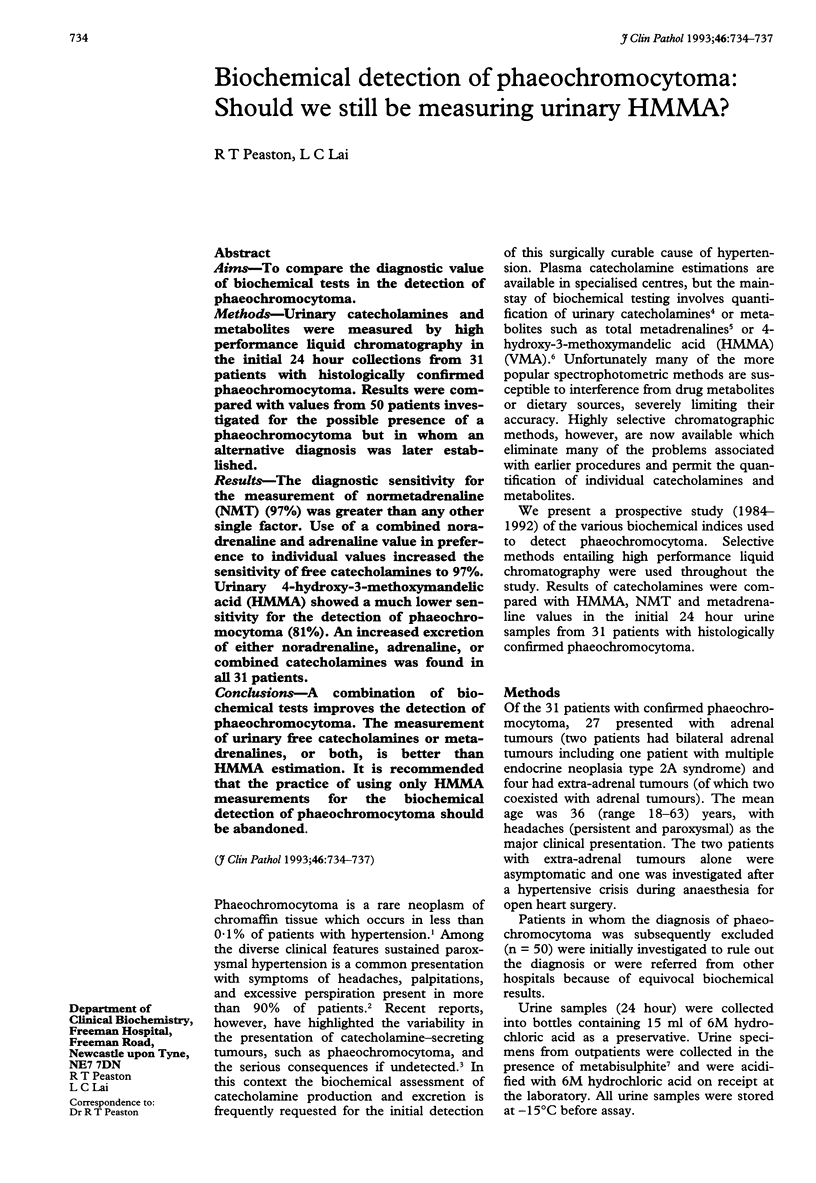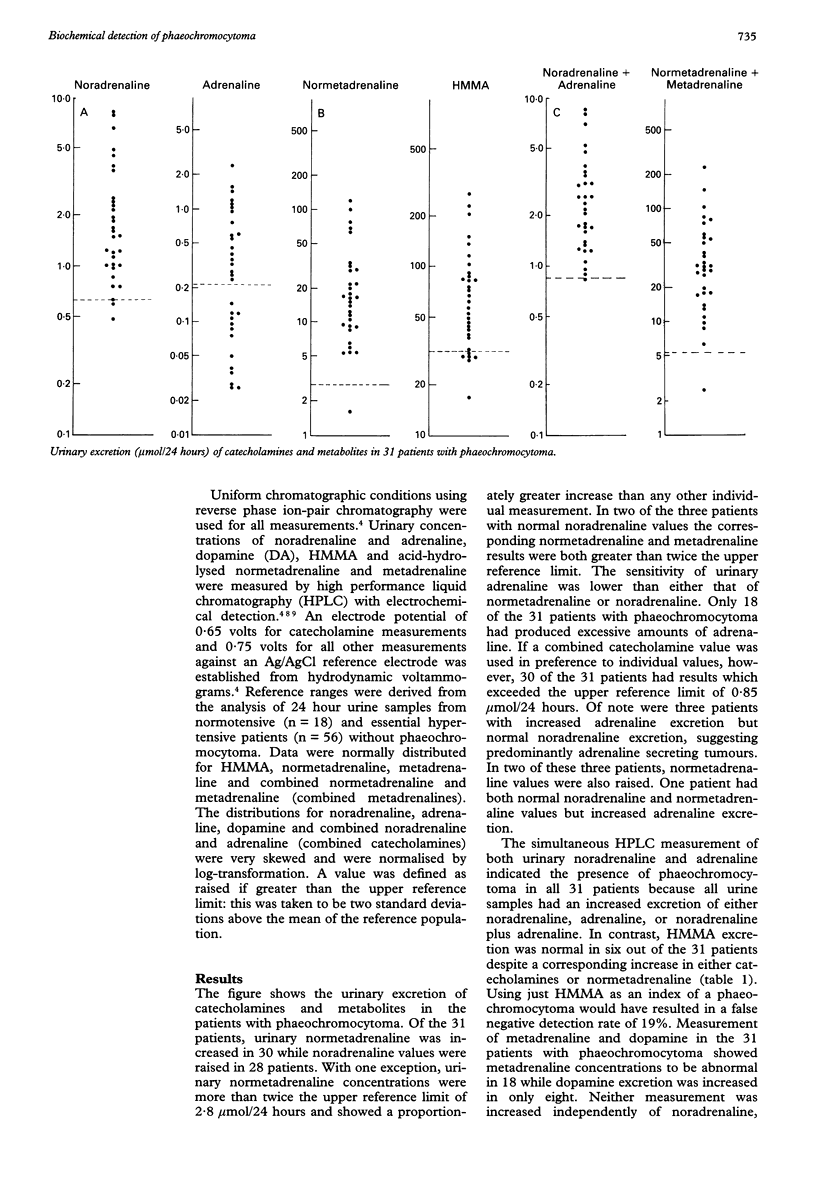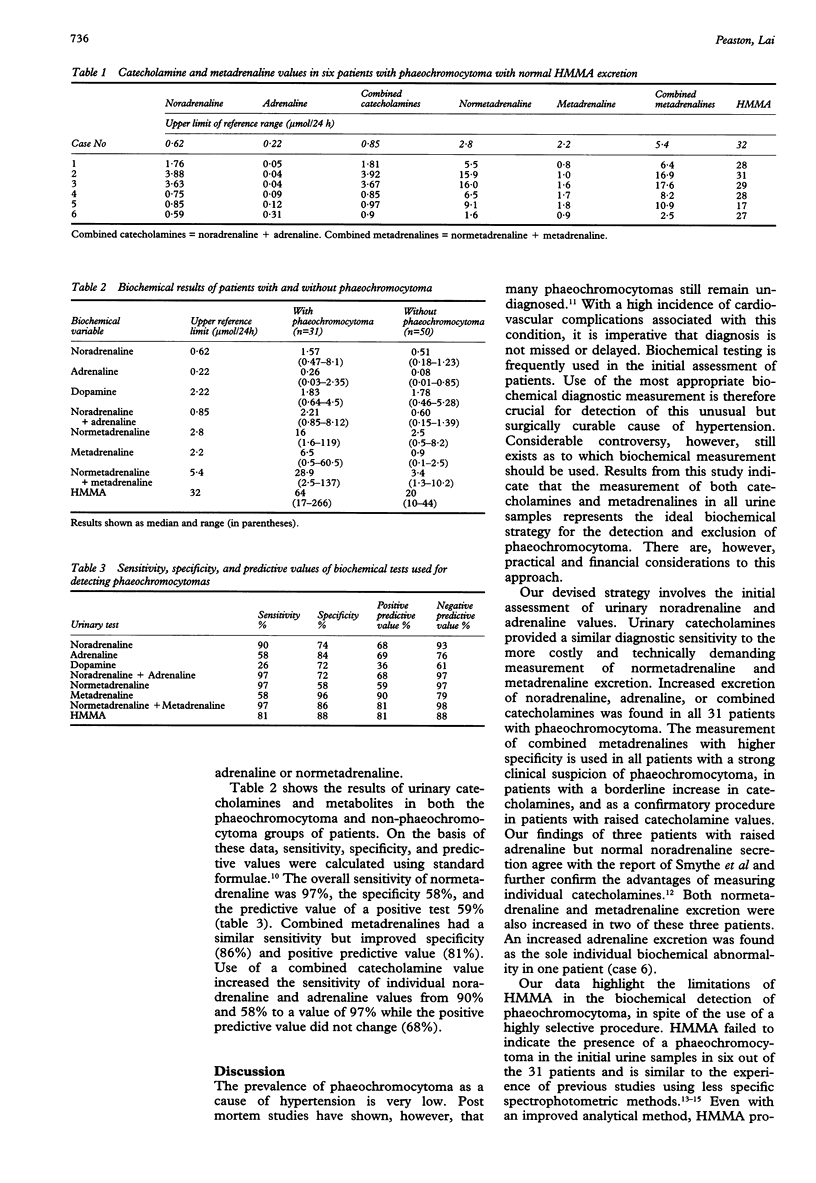Abstract
AIMS--To compare the diagnostic value of biochemical tests in the detection of phaeochromocytoma. METHODS--Urinary catecholamines and metabolites were measured by high performance liquid chromatography in the initial 24 hour collections from 31 patients with histologically confirmed phaeochromocytoma. Results were compared with values from 50 patients investigated for the possible presence of a phaeochromocytoma but in whom an alternative diagnosis was later established. RESULTS--The diagnostic sensitivity for the measurement of normetadrenaline (NMT) (97%) was greater than any other single factor. Use of a combined noradrenaline and adrenaline value in preference to individual values increased the sensitivity of free catecholamines to 97%. Urinary 4-hydroxy-3-methoxymandelic acid (HMMA) showed a much lower sensitivity for the detection of phaeochromocytoma (81%). An increased excretion of either noradrenaline, adrenaline, or combined catecholamines was found in all 31 patients. CONCLUSIONS--A combination of biochemical tests improves the detection of phaeochromocytoma. The measurement of urinary free catecholamines or metadrenalines, or both, is better than HMMA estimation. It is recommended that the practice of using only HMMA measurements for the biochemical detection of phaeochromocytoma should be abandoned.
Full text
PDF



Selected References
These references are in PubMed. This may not be the complete list of references from this article.
- Beard C. M., Sheps S. G., Kurland L. T., Carney J. A., Lie J. T. Occurrence of pheochromocytoma in Rochester, Minnesota, 1950 through 1979. Mayo Clin Proc. 1983 Dec;58(12):802–804. [PubMed] [Google Scholar]
- Binder S. R., Sivorinovsky G. Measurement of urinary vanilmandelic acid and homovanillic acid by high-performance liquid chromatography with electrochemical detection following extraction by ion-exchange and ion-moderated partition. J Chromatogr. 1984 Dec 7;336(1):173–188. doi: 10.1016/s0378-4347(00)85140-3. [DOI] [PubMed] [Google Scholar]
- Bravo E. L., Gifford R. W., Jr Current concepts. Pheochromocytoma: diagnosis, localization and management. N Engl J Med. 1984 Nov 15;311(20):1298–1303. doi: 10.1056/NEJM198411153112007. [DOI] [PubMed] [Google Scholar]
- Brown M. J. Catecholamine measurements in clinical medicine. Postgrad Med J. 1983 Aug;59(694):479–482. doi: 10.1136/pgmj.59.694.479. [DOI] [PMC free article] [PubMed] [Google Scholar]
- CROUT J. R., PISANO J. J., SJOERDSMA A. Urinary excretion of catecholamines and their metabolites in pheochromocytoma. Am Heart J. 1961 Mar;61:375–381. doi: 10.1016/0002-8703(61)90609-3. [DOI] [PubMed] [Google Scholar]
- Macdougall I. C., Isles C. G., Stewart H., Inglis G. C., Finlayson J., Thomson I., Lees K. R., McMillan N. C., Morley P., Ball S. G. Overnight clonidine suppression test in the diagnosis and exclusion of pheochromocytoma. Am J Med. 1988 Jun;84(6):993–1000. doi: 10.1016/0002-9343(88)90303-8. [DOI] [PubMed] [Google Scholar]
- Moleman P. Preservation of urine samples for assay of catecholamines and their metabolites. Clin Chem. 1985 Apr;31(4):653–654. [PubMed] [Google Scholar]
- PISANO J. J. A simple analysis for normetanephrine and metanephrine in urine. Clin Chim Acta. 1960 May;5:406–414. doi: 10.1016/0009-8981(60)90146-7. [DOI] [PubMed] [Google Scholar]
- PISANO J. J., CROUT J. R., ABRAHAM D. Determination of 3-methoxy-4-hydroxymandelic acid in urine. Clin Chim Acta. 1962 Mar;7:285–291. doi: 10.1016/0009-8981(62)90022-0. [DOI] [PubMed] [Google Scholar]
- Peaston R. T. Routine determination of urinary free catecholamines by high-performance liquid chromatography with electrochemical detection. J Chromatogr. 1988 Feb 26;424(2):263–272. doi: 10.1016/s0378-4347(00)81103-2. [DOI] [PubMed] [Google Scholar]
- Ross E. J., Griffith D. N. The clinical presentation of phaeochromocytoma. Q J Med. 1989 Jun;71(266):485–496. [PubMed] [Google Scholar]
- Sardesai S. H., Mourant A. J., Sivathandon Y., Farrow R., Gibbons D. O. Phaeochromocytoma and catecholamine induced cardiomyopathy presenting as heart failure. Br Heart J. 1990 Apr;63(4):234–237. doi: 10.1136/hrt.63.4.234. [DOI] [PMC free article] [PubMed] [Google Scholar]
- Shapiro B., Fig L. M. Management of pheochromocytoma. Endocrinol Metab Clin North Am. 1989 Jun;18(2):443–481. [PubMed] [Google Scholar]
- Smythe G. A., Edwards G., Graham P., Lazarus L. Biochemical diagnosis of pheochromocytoma by simultaneous measurement of urinary excretion of epinephrine and norepinephrine. Clin Chem. 1992 Apr;38(4):486–492. [PubMed] [Google Scholar]
- van Heerden J. A., Sheps S. G., Hamberger B., Sheedy P. F., 2nd, Poston J. G., ReMine W. H. Pheochromocytoma: current status and changing trends. Surgery. 1982 Apr;91(4):367–373. [PubMed] [Google Scholar]


